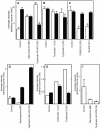Novel protein kinase signaling systems regulating lifespan identified by small molecule library screening using Drosophila
- PMID: 22363408
- PMCID: PMC3282711
- DOI: 10.1371/journal.pone.0029782
Novel protein kinase signaling systems regulating lifespan identified by small molecule library screening using Drosophila
Abstract
Protein kinase signaling cascades control most aspects of cellular function. The ATP binding domains of signaling protein kinases are the targets of most available inhibitors. These domains are highly conserved from mammals to flies. Herein we describe screening of a library of small molecule inhibitors of protein kinases for their ability to increase Drosophila lifespan. We developed an assay system which allowed screening using the small amounts of materials normally present in commercial chemical libraries. The studies identified 17 inhibitors, the majority of which targeted tyrosine kinases associated with the epidermal growth factor receptor (EGFR), platelet-derived growth factor (PDGF)/vascular endothelial growth factor (VEGF) receptors, G-protein coupled receptor (GPCR), Janus kinase (JAK)/signal transducer and activator of transcription (STAT), the insulin and insulin-like growth factor (IGFI) receptors. Comparison of the protein kinase signaling effects of the inhibitors in vitro defined a consensus intracellular signaling profile which included decreased signaling by p38MAPK (p38), c-Jun N-terminal kinase (JNK) and protein kinase C (PKC). If confirmed, many of these kinases will be novel additions to the signaling cascades known to regulate metazoan longevity.
Conflict of interest statement
Figures








Similar articles
-
Acrolein activates mitogen-activated protein kinase signal transduction pathways in rat vascular smooth muscle cells.Mol Cell Biochem. 2002 Nov;240(1-2):83-98. doi: 10.1023/a:1020659808981. Mol Cell Biochem. 2002. PMID: 12487375
-
SnapShot: Kinase Inhibitors I.Mol Cell. 2015 May 21;58(4):708.e1. doi: 10.1016/j.molcel.2015.05.001. Mol Cell. 2015. PMID: 26000854
-
SnapShot: Kinase Inhibitors II.Mol Cell. 2015 May 21;58(4):710.e1. doi: 10.1016/j.molcel.2015.05.002. Mol Cell. 2015. PMID: 26000855
-
A historical overview of protein kinases and their targeted small molecule inhibitors.Pharmacol Res. 2015 Oct;100:1-23. doi: 10.1016/j.phrs.2015.07.010. Epub 2015 Jul 21. Pharmacol Res. 2015. PMID: 26207888 Review.
-
Human Protein Kinases and Obesity.Adv Exp Med Biol. 2017;960:111-134. doi: 10.1007/978-3-319-48382-5_5. Adv Exp Med Biol. 2017. PMID: 28585197 Review.
Cited by
-
Joint inhibition of TOR and JNK pathways interacts to extend the lifespan of Brachionus manjavacas (Rotifera).Exp Gerontol. 2014 Apr;52:55-69. doi: 10.1016/j.exger.2014.01.022. Epub 2014 Jan 29. Exp Gerontol. 2014. PMID: 24486130 Free PMC article.
-
Nordihydroguaiaretic Acid Extends the Lifespan of Drosophila and Mice, Increases Mortality-Related Tumors and Hemorrhagic Diathesis, and Alters Energy Homeostasis in Mice.J Gerontol A Biol Sci Med Sci. 2015 Dec;70(12):1479-89. doi: 10.1093/gerona/glu190. Epub 2014 Nov 7. J Gerontol A Biol Sci Med Sci. 2015. PMID: 25380600 Free PMC article.
-
Finding Ponce de Leon's Pill: Challenges in Screening for Anti-Aging Molecules.F1000Res. 2016 Mar 29;5:F1000 Faculty Rev-406. doi: 10.12688/f1000research.7821.1. eCollection 2016. F1000Res. 2016. PMID: 27081480 Free PMC article. Review.
-
Combined statin and angiotensin-converting enzyme (ACE) inhibitor treatment increases the lifespan of long-lived F1 male mice.Age (Dordr). 2016 Dec;38(5-6):379-391. doi: 10.1007/s11357-016-9948-4. Epub 2016 Sep 2. Age (Dordr). 2016. PMID: 27590905 Free PMC article.
-
JAK inhibition by methotrexate (and csDMARDs) may explain clinical efficacy as monotherapy and combination therapy.J Leukoc Biol. 2019 Nov;106(5):1063-1068. doi: 10.1002/JLB.5RU0519-145R. Epub 2019 Jul 16. J Leukoc Biol. 2019. PMID: 31313387 Free PMC article. Review.
References
Publication types
MeSH terms
Substances
LinkOut - more resources
Full Text Sources
Other Literature Sources
Molecular Biology Databases
Research Materials
Miscellaneous

